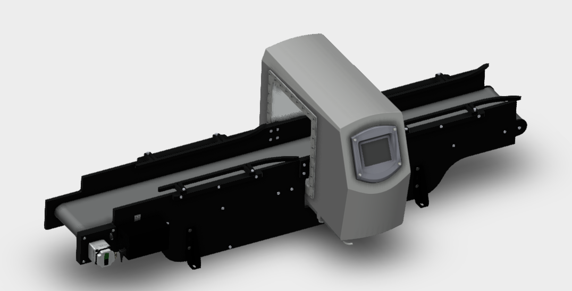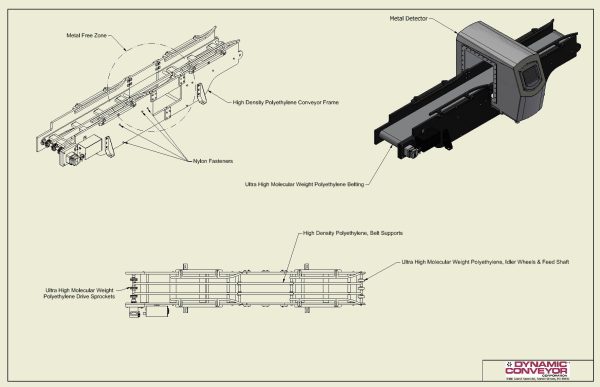In today’s ever changing industrial space, where the speed and complexity of innovation in manufacturing are increasing daily, the need for specialty equipment to support these operations continues to rise. This holds true for material handling, where increased automation improves efficiencies, reduces maintenance, and drives an overall improved bottom line for end users. One specialty application in material handling that few OEMs have been able to effectively deliver on is providing a metal free conveyor. Many may ask where would this be necessary? Let’s dive into a few applications for metal free conveyors.
Applications
There are two primary areas where the use of a mostly plastic conveyor is critical to the success of the operation: metal detection and caustic/corrosive environment applications.
Metal Detection Conveyors
The use of metal detectors or a metal detector conveyor system in manufacturing, food, pharmaceutical and other industries continue to increase as a way of improving safety and quality, while reducing manual labor. While it would make sense to assume that a metal detector would require an entirely metal free conveyor, in most cases, only a metal free zone is required. The required metal free zone depends on several factors including, but not limited to, the type of metal detector (plate or aperture style), sensitivity, and mounting location on the conveyor. Below is an example of an aperture style metal detector on a Hybrid conveyor designed, engineered and manufactured by Dynamic Conveyor.

Figure 1: Aperture Style
Caustic & Corrosive Resistant Conveyors
The second application where the use of a metal free conveyor can add significant value to an operation is in caustic or corrosive environments. Examples of these environments include the manufacturing, handling, bottling, or packaging of highly corrosive or caustic chemicals where metal materials and components will quickly be destroyed by the product or even the atmosphere. Specialty manufacturing operations such as battery cell manufacturing, agricultural products, and pharmaceuticals are examples of applications that warrant the use of metal free conveyors. Corrosion not only compromises the structural integrity of metal conveyors, but also poses serious contamination risks to the materials being transported.
Challenge #1: Construction of Metal Free Conveyors
In today’s world of conveyor manufacturing, steel and aluminum frame conveyors are overwhelmingly the most common conveyor design on the market. In addition to the metal framing, they utilize steel fasteners, drive shafts, leg supports, and idler assemblies, all of which combine to make them a challenging fit. Metal conveyors and metal components don’t work well in a caustic environment because the caustic substances can cause rapid corrosion and deterioration of the metal components causing increased maintenance costs, more frequent replacements and potential production downtime. Non-corrosive stainless steel is very difficult to find with Alloy 20 being just one of few that could withstand sulfuric acid and they come at a premium price. End users are challenged to find solutions for metal free conveyance because the options are limited.
Challenge #2: Design of Metal Free Conveyors
When designing a metal free plastic conveyor, there are several considerations that must be taken into account to ensure the proper form, fit and function for the application. In the food industry for example, conveyors are routinely integrated with metal detectors to ensure food safety. However, it is imperative that in doing so, sanitary design standards are considered to align with the sanitary standards of the facility. With proper planning and the right partner, a metal free plastic conveyor can be designed and manufactured while complying with sanitary conveyor standards. Other considerations that impact conveyor design and need to be considered include:
- Products being conveyed
- Required speed/throughput of the application
- Type of metal free application, ie. does it require a metal free zone, or a completely metal free conveyor
- Integrations with other equipment
- Method and frequency of cleaning
Plastic, Metal Free Conveyors: Our Solution to Metal Free Zone Requirements
In its thirty plus years of operation, Dynamic Conveyor has proven that its conveyor lines constructed of high-performance thermoplastic stand up to a wide variety of manufacturing, food processing, pharmaceutical, and packaging applications. Ultra-High Molecular Weight Polyethylene (UHMWPE) is highly effective in corrosive environments due to its exceptional chemical resistance. Unlike many other materials, UHMWPE is virtually unaffected by most chemicals, including strong acids, alkalis, and organic solvents. This resilience stems from its dense molecular structure, which provides a robust barrier against chemical attack. Additionally, UHMWPE’s low moisture absorption prevents it from degrading or swelling in wet conditions, further enhancing its durability in corrosive settings. Its ability to maintain mechanical properties under these harsh conditions makes UHMWPE an ideal choice for a variety of challenging applications including where chemical exposure is a concern.
Dynamic Conveyor Corporation has taken this experience and quickly become a leader by providing metal free conveyor solutions constructed entirely from plastic. At first, one may wonder about the durability and longevity of a plastic conveyor solution in today’s demanding manufacturing environments, however, Dynamic Conveyor’s plastic conveyor systems have demonstrated time and again their ability to exceed customer expectations . The Hybrid specialty conveyor line, known for its modularity, ability to solve unique challenges, and durability, is offered with an option to feature no metal components. This allows for a completely metal free conveyor for the most challenging of applications.
Here are just some of the components Dynamic Conveyor’s metal free plastic conveyors are designed with:
- Conveyor Frame – High Density Polyethylene
- Belt Supports – Ultra High Molecular Weight Polyethylene
- Idler Shaft & Drive Shaft – Acetal
- Belting – Various options of Intralox belting solutions, commonly link style polypropylene belting
- Drive Sprockets & Idler Wheels – Acetal
- Fasteners – Nylon
Advantages of Metal Free Conveyors
With the continued advancement of high-performance materials outside of metals, alternatives to the traditional steel or aluminum framed conveyor are not only possible, but available on the market today. These metal free, plastic conveyors offer end users the ability to truly implement the best equipment solutions for their operations, ensuring maintenance, repairs, and ultimately downtime are reduced or eliminated. Take for example this bottling application where the customer was accustomed to replacing their conveyors on an annual basis and considered this a necessity of their industry. Now after six years with the right plastic conveyor in place, they have not had to replace it once, saving both capital and operating expenses.
Metal free conveyors offer new capabilities to users with the most challenging conveyance needs. In doing so, they provide for a cost-effective upfront investment while ensuring significant reductions in repair and replacement costs over time relative to a metal conveyor. This results in a low total cost of ownership over the life of the machine.
Don’t settle. Alternatives to the traditional steel and aluminum conveyors exist and can provide for significant upside for their users when implemented into the appropriate applications. Dynamic Conveyor’s metal-free conveyors resistance to corrosion, chemical compatibility, lightweight design, and hygienic properties make them indispensable assets in industries where reliability, durability, and product integrity are vital.
Selecting the right partner with appropriate experience for any application is an important first step. Dynamic Conveyor Corporation has proven itself as a leader in engineering and manufacturing metal-free plastic conveyors under the Hybrid Conveyor line. Contact us to share your application and your challenges, we’ll work with you to develop a solution.
- Modern Conveyance and Automation in Food Manufacturing - March 21, 2025
- Dynamic Conveyor and Muskegon Middle School: A Collaborative Journey in Design Thinking - February 17, 2025
- Upgrading 30 Years of Reliable Conveyor Performance for a Souvenir Manufacturer - February 3, 2025


